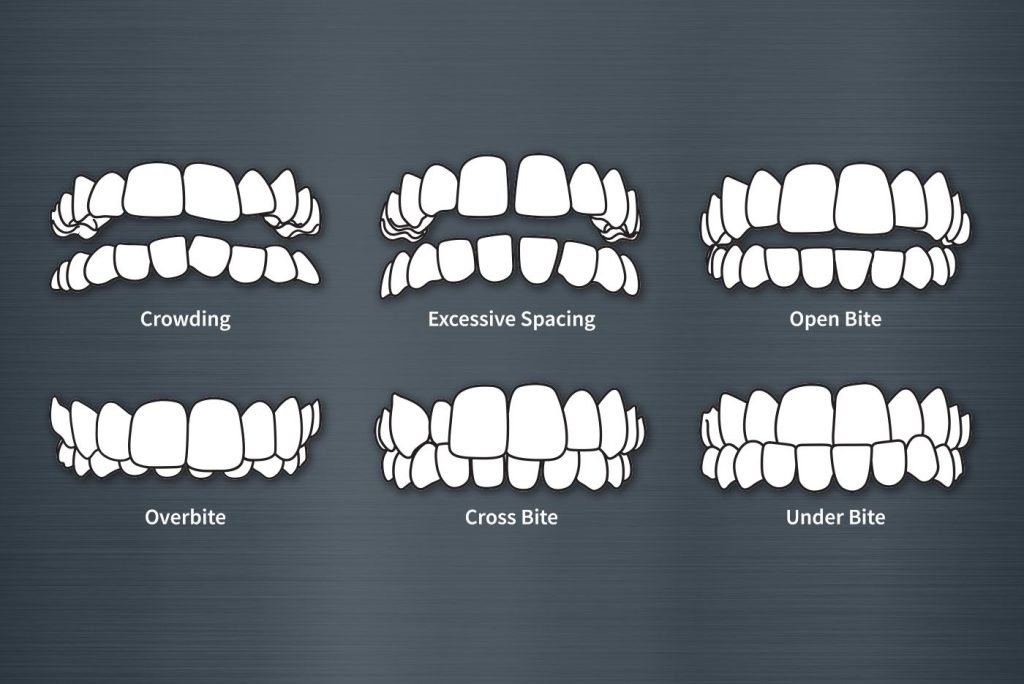
Bite Correction With Braces
Bite Correction with Braces : A misaligned bite, also known as a malocclusion, is a dental condition where the upper and lower teeth do not fit together properly when the jaws are closed.
This misalignment can result from various factors, such as genetics, childhood habits, thumb sucking, early tooth loss, or jaw injuries. A misaligned bite can manifest in different ways, and the severity can vary from mild to severe.
A misaligned bite not only affects the aesthetics of the smile but can also lead to various oral health issues
- It may cause difficulty in maintaining proper oral hygiene, which can increase the risk of tooth decay, gum disease, and other dental problems.
- Additionally, some misaligned bites can contribute to jaw joint (TMJ) issues, leading to jaw pain, headaches, and discomfort.
An orthodontist or dentist can diagnose the specific type and severity of the misalignment and recommend appropriate treatments, such as braces or other orthodontic appliances, to correct the bite.
Common types of misaligned bite Correction with Braces
- Overbite: An overbite occurs when the upper front teeth excessively overlap the lower front teeth when the mouth is closed. In severe cases, the lower teeth may bite into the roof of the mouth. Overbites can lead to difficulties in biting and chewing, speech problems, and potential wear on the front teeth.
- Underbite: An underbite is characterized by the lower front teeth protruding forward, overlapping the upper front teeth when the mouth is closed. This can result in an imbalanced facial appearance and may lead to issues with chewing, speech, and jaw discomfort.
- Crossbite: A crossbite occurs when one or more upper teeth bite inside the lower teeth or vice versa when the jaws are closed. This lateral misalignment can cause uneven wear on the teeth, gum problems, and jaw pain.
- Open Bite: An open bite is characterized by a space between the upper and lower front teeth when the back teeth are closed together. This condition can result in difficulty with biting and chewing certain foods and may lead to speech problems.
- Crowding: Crowding happens when there is not enough space in the jaw to accommodate all the teeth, causing them to overlap or twist. Crowded teeth can be challenging to clean properly, increasing the risk of decay and gum problems.
- Spacing: Spacing refers to gaps or spaces between teeth, which can be caused by missing teeth or an excess of space in the jaw. Spacing issues can affect the appearance of the smile and may impact proper biting and chewing.
How Bite Correction with Braces is Done
Braces are a commonly used orthodontic treatment method to correct various bite issues. They work by applying continuous gentle pressure to the teeth and jaws over a period of time, gradually moving them into their proper positions. The main goals of braces in bite correction include:
- Aligning the Teeth: Braces help align teeth that are misaligned, crooked, or crowded, bringing them into their optimal positions.
- Correcting Jaw Misalignment: Braces can also address bite problems that arise from jaw misalignment, such as overbite, underbite, crossbite, or open bite. By gradually shifting the position of the teeth, braces help in improving the alignment of the jaws and achieving a proper bite relationship.
- Creating Proper Spacing: In cases of spacing issues, braces can help close gaps between the teeth by shifting them closer together.
Braces are often used with some other orthodontic appliances for bite correction.
Appliances Used for Bite Correction with Braces
Bite correction can be achieved using a variety of orthodontic appliances, each tailored to address specific types of bite issues. The types of braces and orthodontic appliances commonly used for bite correction include:
- Traditional Metal Braces: These are the most common type of braces used for bite correction. They consist of metal brackets bonded to the front surface of the teeth and connected with metal wires.
- Ceramic Braces: Similar in design to traditional braces, ceramic braces are made of tooth-colored or clear ceramic material, making them less noticeable.
- Lingual Braces: Lingual braces are fixed braces that are placed on the inner surfaces of the teeth, making them virtually invisible from the outside. They are an excellent choice for patients who desire a completely hidden orthodontic treatment for their bite problems.
- Clear Aligners: Clear aligners, such as Invisalign®, are a series of removable, custom-made trays that gradually shift the teeth into their desired positions. They are an attractive option for patients seeking a more flexible and discreet treatment approach for mild to moderate bite issues.
- Palatal Expanders: Palatal expanders are used to address issues related to a narrow upper jaw. This appliance gently widens the upper jaw by applying pressure on the palate. Palatal expanders are commonly used in growing children to create more space for the teeth and improve overall bite alignment.
- Headgear: Headgear is an external orthodontic appliance used to correct overbite and other jaw alignment issues. It consists of a neck strap or head cap connected to braces or a facebow to exert pressure on the upper jaw and align it with the lower jaw.
- Orthodontic Rubber Bands (Elastics): Rubber bands are small elastics that connect different parts of braces to apply specific forces, helping to correct bite discrepancies and jaw alignment. They are often used in conjunction with braces or other appliances to achieve optimal bite correction.
Each of these braces and orthodontic appliances serves a specific purpose in addressing different bite issues. The choice of the most suitable option depends on the type and severity of the bite problem,
time period for Bite Correction
The time period required for bite correction can vary significantly depending on the severity of the misalignment, the type of bite issue, the chosen treatment method, and the individual’s response to treatment. It’s important to understand that every case is unique, and the duration of bite correction can differ from person to person.
Generally, the average time frames for different types of bite correction treatments are as follows:
- Minor Bite Issues: For mild cases of misaligned bites, such as slight crowding or minor spacing, treatment with clear aligners or minor orthodontic appliances may take around 6 to 12 months. In some cases, treatment may even be completed within 3 to 6 months.
- Moderate Bite Issues: Bite corrections for more moderate problems, such as moderate crowding or spacing, may typically take around 12 to 18 months with traditional braces or clear aligners.
- Severe Bite Issues: Cases involving severe misalignments like significant overbites, underbites, or extensive crowding may require longer treatment times, ranging from 18 months to 2 or more years, depending on the complexity of the case and the chosen treatment method.
If you are Looking for Bite Correction with Braces
If you are seeking effective bite correction and a beautiful, healthy smile, look no further than the Center for Dental Implants & Esthetics. Our experienced team of orthodontic specialists is dedicated to providing personalized treatment plans to address your specific bite issues and achieve optimal results.
Whether you are dealing with an overbite, underbite, crossbite, or any other misalignment, we offer a wide range of orthodontic solutions, including traditional braces, clear aligners, ceramic braces, and more. Our state-of-the-art facility and advanced techniques ensure that you receive the highest standard of care in a comfortable and welcoming environment.
Additional Reading About Orthodontics
- Read This Before You Get Dental Braces
- Pros & Cons of Lingual Braces (Braces Behind the Teeth)
- Dental Braces in Gurugram: Center for Dental Implants & Esthetics
- Gap in Teeth Treatment
- How Braces Work : A Guide for Beginners
- Aligners
- Bite Correction With Braces
- WHAT ARE BENEFITS OF INVISALIGN FOR ADULTS?
- Try Jaw Alignment with Braces : Forget Jaw Alignment Surgery
- The 8 Differences Between Invisalign Vs. Ceramic Braces
- WHAT ARE BENEFITS OF INVISALIGN FOR ADULTS?
- Straighten Your Teeth With Clear Aligners
- Invisalign : Only by Invisalign Certified Expert Gurgaon
- What Is The Best Age For Your Kid To Get Orthodontic Braces?
- Braces vs Aligners
- Orthognathic Surgery : Questions Answered
- Self Ligating Braces vs Conventional Braces
- Gap in Teeth Treatment
- Why Choose Invisalign over Cheaper Aligners
- ब्रेसेस (दांत में तार – टेढ़े मेढ़े दांत )

Dr. Jyoti Singh (MDS), Diplomate WICO (Japan region) stands as a beacon of excellence in implantology within Delhi NCR region. She is a BDS and MDS(Prostho) both from Maulana Azad Institute of Dental Sciences, where she secured top honors with all India rank 1 in PG entrance examination. Her extensive experience at esteemed institutions like Clove Dental and her own Center for Dental Implants & Esthetics since 2016, Dr. Singh embodies unparalleled expertise in dental implants. Boasting a wealth of 16 years in dentistry and backed by 18 groundbreaking research papers in leading international journals (Google Scholar) and her ResearchGate profile, she epitomizes the pinnacle of proficiency and innovation in her field. She practices in Gurugram as your friendly dentist near me.
